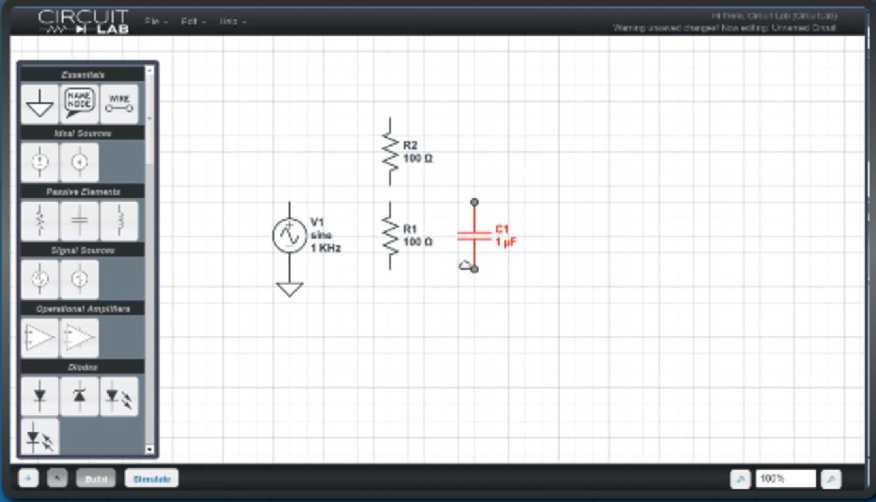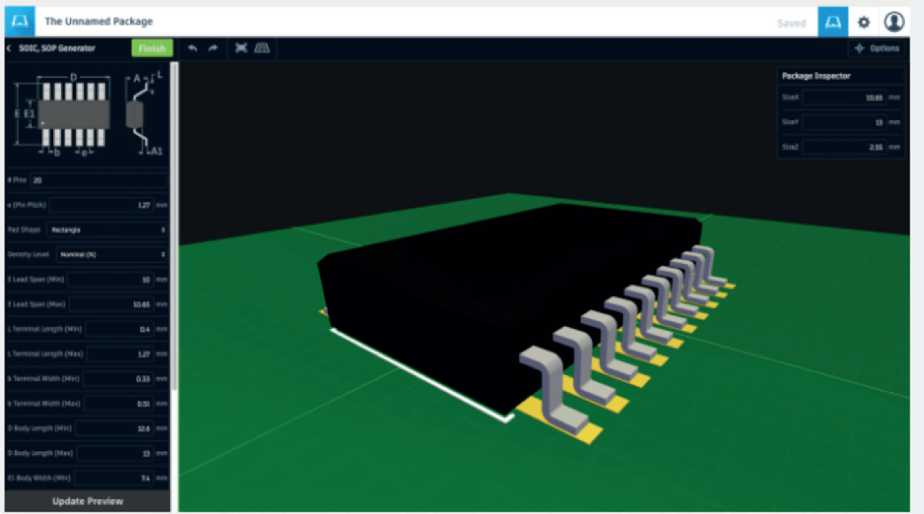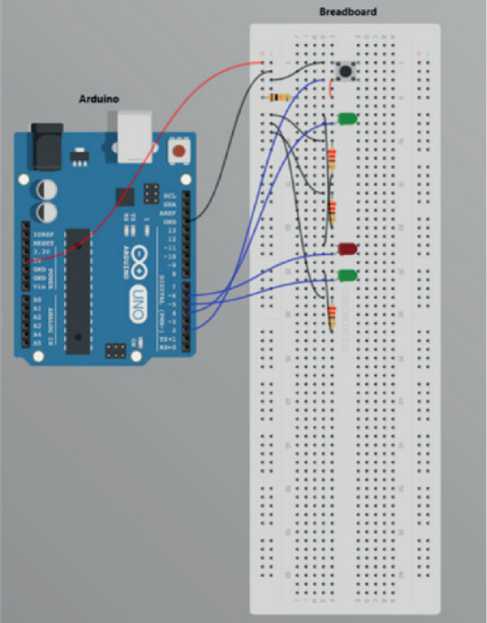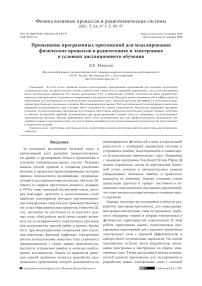Применение программных приложений для моделирования физических процессов в радиотехнике и электронике в условиях дистанционного обучения
Автор: Манукян В.К.
Журнал: Физика волновых процессов и радиотехнические системы @journal-pwp
Статья в выпуске: 1 т.24, 2021 года.
Бесплатный доступ
В этой статье проведен анализ существующих программных приложений для создания прототипов электронных схем, которые помогут оценить работу всей схемы как по заданным параметрам, так и для нахождения более оптимальных вариантов. На основе приложения TAC и библиотеки Arduino компонентов были разработаны проекты и инструкции по созданию и тестированию электронных схем. Проведен анализ возможностей и эффективности приложения для тестирования и создания новых электронных схем с оценкой простоты интерфейса и пользовательских параметров, близких к реальным условиям. Использование приложения TAC дает возможность сгенерировать несколько вариантов альтернативных схем, которые могут подходить из списка компонентов. Результаты апробации программ показали, что использование приложения для создания прототипов микросхем значительно ускоряет процесс обучения и помогает устранению проблем, возникающих при проектировании и сборке схем, по сравнению с использованием традиционных методов. Данные приложения могут быть адаптированы как под профессиональное пользование для дизайна сложных электронных схем, так и для учебных пособий для студентов технических вузов в качестве практических и творческих заданий.
Прототипы электронных схем, схемотехника, микроэлектроника, виртуальные схемы, дистанционное обучение
Короткий адрес: https://sciup.org/140256335
IDR: 140256335 | УДК: 53.072.13 | DOI: 10.18469/1810-3189.2021.24.1.89-97
Текст научной статьи Применение программных приложений для моделирования физических процессов в радиотехнике и электронике в условиях дистанционного обучения
За последнее десятилетие большой спрос и интенсивный рост развития микроэлектроники привел к расширению области применения и усиления микропроцессорных систем. Развитие данных систем привело к созданию различных методик и продуктов прототипирования, которые широко используются дизайнерами, производителями и исследователями во многих областях [1]. Одним из первых прототипов являлось создание в 1970-х годах макетной беспаечной платы, которая благодаря простоте в использовании стала наиболее популярным методом прототипирования электронных схем как для производственных, так и для образовательных проектов. Известно [2], что, несмотря на доступность и простоту данных плат, сбой работы всей схемы может возникать из-за неправильного подключения проводов или компонентов, плохой пайки и прочее. Кроме того, при моделировании повышения или усиления некоторых функций цифровых электронных систем использование макетных плат становится нерациональным с точки зрения практичности, быстроты устранения ошибок и наличия необходимых компонентов. Одним из вариантов решения данной проблемы является разработка программного приложения, которое основывается на
моделировании физической схемы в виртуальной реальности с подборкой параметров системы и устранения ошибок, моделирования и совместного использования виртуальных схем. Например, с помощью программы Toastboard [3] или PSpice [4] можно нарисовать схемы на виртуальной макетной плате, которая в автоматическом режиме обнаруживает типичные ошибки и предлагает варианты их решения. Однако создание схемы происходит вручную и требует постоянного обновления пользователем для данных приложений, что тоже является непрактичным и занимает много времени.
Однако, несмотря на достижения в области разработки программ-прототипов, для моделирования микроэлектронных схем по-прежнему требуются обширные знания в теории электроники и физических характеристик компонентов. В этой работе представлен анализ существующих программных приложений для создания прототипов электронных схем с оценкой эффективности и выбора более оптимальных вариантов. На основе приложения Arduino были разработаны обучающие программы и инструкции по сборке электронных схем. Также представлен анализ возможностей данного приложения для тестирования и разработки новых электронных схем с оценкой
LM^^e © Манукян В.К., 2021

Рис. 1. Интерфейс программы Fritzing на основе платы Arduino для проектирования электронных схем [10]
Fig. 1. Fritzing program interface based on Arduino board for designing electronic circuits [10]
простоты интерфейса и пользовательских параметров, близких к реальным условиям. Предложенные программные приложения могут быть адаптированы как под профессиональное пользование для дизайна сложных электронных схем, так и для учебных пособий для студентов технических вузов в качестве практических и творческих заданий в условиях дистанционного обучения.
1. Особенности программ прототипирования электронных схем
Аппаратно-программные средства Arduino являются одним из популярных и широко распространенных платформ для построения простых интегральных систем [5]. Программная часть часто используется для написания программ, их компиляции и программирования аппаратной части. Обычно данная часть представляет собой смонтированные печатные платы. Поэтому средства Arduino используются наиболее часто для создания программ моделирования микросхем в производственных и обучающих проектах. Однако, несмотря на простоту приложения, пользователи сталкиваются с такими проблемами, как неправильный подбор и подключение компонентов, использование неправильной логики и переменных [6]. Особенно это касается студентов и новичков, которые хотят освоить микроэлектронику. Так для обеспечения простой и понятной абстракции в программном обеспечении при проектировании микросхем необходимо дополнить приложения Arduino новыми инструментами и дополнения новыми компонентами [7].
Multimeter, Oscilloscope, Digilent Electronics Explorer, Toastboard применяются для отладки используемых макетных плат [8]. Например, в приложении Toastboard применяется макетная плата с вольтметрами для визуализации показаний напряжения всей макетной платы и использования исторических данных [9]. Кроме того, в него включены функции отладки системы, которые сопоставляют ошибки с шаблонами общих ошибок и предлагают необходимые решения. Однако это приложение не обнаруживает физические провода и компоненты в цепи.
Программное приложение Fritzing также используется для виртуального моделирования электронных схем и оборудования на основе Arduino-прототипов. При помощи этой программы можно преобразовать прототип в топологию печатной платы. Пример интерфейса приложения Fritzing показан на рис. 1. Данная программа также предусматривает широкую базу данных компонентов с различными характеристиками.

Рис. 2. Интерфейс программы CircuitLab для создания электронных цепей и проектирования электронных схем [14]
Fig. 2. Interface of the CircuitLab program for creating electronic circuits and designing electronic circuits [14]
Как видно из рис. 2, Fritzing использует макетные платы Arduino различной конфигурации. Для создания прототипа схемы достаточно выбрать из перечисленных компонентов необходимый и разместить на нужное место на плате, добавлять другие платы, создавать более сложные схемы. Как указывают производители, данное приложение простое в использовании и позволяет применять его в обучающем процессе и для выполнения собственных проектов. Однако, как и во многих продуктах коммерческих компаний, добавление своих продуктов, пополнение библиотеки компонентов вызывают сложности работы с Fritzing. Также многие продукты и пакеты небесплатные, что ограничивает доступ для большинства пользователей. Так, в [11] авторы на основе 4000 различных вариаций шаблонов автозаполнения разработали дополнительный пакет AutoFritz для прототипирования виртуальных схем, которые могут быть использованы также в качестве учебного пособия и для работы над ошибками. Для сравнения состояния аппаратной части с прототипом, диагностирования возникающих проблем и анализа ошибок, возникающих в цепи, были разработаны такие программные продукты, как CircuitSense [12] и Bifrost [13]. Также инструменты CircuitLab [14] и AutoDesk Circuits [15] позволяют пользователям создавать виртуальные схемы с последующей проверкой посредством моделирования реальных условий (рис. 2 и 3).
CircuitLab (см. рис. 2) имеет достаточно простой и понятный интерфейс для пользователя, а также введения схематических обозначений упрощает задачу для решения практических заданий и проверки правильности соединений. Простая сборка и проверка работы цепи сделали данное приложение популярным в учебных целях. Однако разработку учебного пакета и покупку лицензионного соглашения рационально использовать непосредственно в учебном классе, но невыгодно для удаленных пользователей.
AutoDesk Circuits отличается от предыдущих тем, что для моделирования использует трехмерные модели реальных компонентов от различных производителей (рис. 3) с описанием физических параметров. Также библиотека данных постоянно обновляется, и достаточно широкий спектр оборудования позволяет моделировать реальные проекты, которые могут реализовываться в их производстве. Эта программа пользуется большой популярностью у дизайнеров и разработчиков интегральных схем, инженеров робототехники и электроники.
Проект VISIR, основанный на создании удаленной лаборатории, позволяет подключать и тестировать электронные схемы на виртуальном рабочем месте, не находясь в лаборатории, путем копирования прототипов виртуальных схем [16].
Исходя из приведенного выше обзора различных программных приложений, разработанных для прототипирования электронных схем, сле-

Рис. 3. Пример описания оборудования из библиотеки программы AutoDesk Circuits [15]
Fig. 3. Example of a description of equipment from the library of the AutoDesk Circuits program [15]
дует, что для отлаженной работы и приближения виртуальных схем к реальным объектам при разработке программного пакета необходимо учитывать простоту в пользовании интерфейсом программы, использование большой библиотеки компонентов и шаблонов схем, макетные платы, классификацию шаблонных макетов по классу функционирования.
В качестве средства, позволяющего определять необходимые правила, цели и ограничения, при разработке программы используется подход производительного проектирования, который предоставляет необходимые инструменты для изменения дизайна [17]. Эта возможность позволяет изучать различные альтернативы, используя вычислительную мощность, и оценивать большее количество проектов, созданных различными студентами. Данный подход может быть использован в учебном процессе, обеспечивая платформу для введения ключевых концепций.
2. Дизайн приложения для изучения микроэлектроники для студентов
Основная цель – разработать систему, способную генерировать электронные схемы с доступной и простой инструкцией по сборке на основе описания желаемой функциональности схемы. Это можно осуществить, применяя подход производительного проектирования с помощью триггеров (входов) и выходов, которая используется в приложении ТАС [18]. Эта спецификация дает возможность генерировать множество вариантов схем, используя заданный набор компонентов, с предоставлением альтернатив для выбора. Это позволяет наглядно оценить возможности и варианты решения поставленной задачи. С помощью предложенных схем-макетов пользователь может создать соответствующую схему, следуя инструкции по сборке. Такой подход дает возможность студенту выбрать один из вариантов для того, чтобы собрать схему и проверить ее производительность для реализации поставленной преподавателем задачи. За основу макетных плат и библиотеки компонентов берется Arduino.
3. Алгоритм построения схемы
В зависимости от поставленной задачи необходимо выбрать количество компонентов, которые можно реализовать путем перемещения элементов из боковых панелей на рабочий экран (рис. 4). Пользовательский интерфейс разделен на пять панелей для каждой из задач, которые пользователь должен выполнить, чтобы построить свою схему.
При выборе схемы из диалогового окна списка схем с оценкой мощности, объема, занимаемого на плате, сложности схемы можно подобрать подходящий вариант для достижения поставленной цели. Таким образом, в автоматическом режиме система подбирает варианты компонентов из библиотеки Arduino, которые можно использовать.

Рис. 4. Выбор компонентов и связующих элементов для построения микросхемы
Fig. 4. Choice of components and connecting elements for the construction of the microcircuit
Это очень удобно и занимает немного времени по сравнению с приложениями, где пользователь ищет в списке название и характеристики каждого компонента. Кроме того, просчет параметров конструкции и вычисление мощности также занимают время и приводят к частым ошибкам, в итоге на выполнение задание может не хватить времени академической пары или заданного времени на выполнение тестового задания. При помощи подхода производительного проектирования эти проблемы решаются в режиме реального времени. Кроме того, можно использовать фильтры при поиске вариантов. Например, установить один или несколько компонентов или название платы. Все эти тонкости должны быть оговорены при составлении тестового или лабораторного задания. После изучения нескольких вариантов схем с помощью функции фильтрации список схем уменьшается, что значительно сокращают поиски необходимого варианта, который сортируется от простого к сложному из необходимых компонентов.
Следующим шагом является сборка схемы на виртуальном рабочем столе (тестовое окно). Начало сборки осуществляется с обзора компонентов и их размещения на макетной плате (рис. 5).
При наведении курсора к компоненту всплывают подсказки о параметрах и свойствах компонента и советах по сборке, после чего пользователь может совершать сборку и загружать код в Arduino для обеспечения обратной связи и для последующей апробации собранной схемы.
Также в режиме теста можно выбрать варианты для модернизации схемы или подключения дополнительных компонентов, которые можно

Рис. 5. Макет электрической схемы прототипа
Fig. 5. Layout of the electric circuit of the prototype
осуществлять в режиме ручной настройки на макетной схеме, после чего также загрузить код и провести тестирование схемы.
Адаптировать описанное выше программное обеспечение под учебный процесс является несложной задачей, поскольку использовать данное приложение могут как новички, так и специалисты для создания более сложных схем, моделирования проектов. Кроме того, руководство по сборке предоставляют студенту пошаговую инструкцию по подключению полученной схемы, где каждый шаг описан в тексте и одновременно обучает техническим терминам и обозначениям в микроэлектронике. Данный подход помогает не только получать необходимые знания по электронике, но и может быть использован в качестве обучающего материала, если студент пропустил лекцию или не разобрался в материале.
Для проверки эффективности программного приложения были разработаны 20 проектов в качестве учебного пособия для дисциплины «Микроэлектроника» в стартовом наборе Arduino с широким диапазоном схем, которые охватывают широкий спектр функций: создание и считывание цифровых и аналоговых сигналов, последовательности связи. Для создания библиотеки использовались широкий спектр электронных компонентов и прописывание подробного руководства для каждого, учитывая технологические характеристики от производителя, и прочее. Тестирование системы производилось с помощью рабочей группы из 10 студентов. Регистрация и учет ошибок производились с помощью заполнения журнала с фиксацией времени начала и окончания на обучение и сборку каждого проекта.
4. Результаты апробации и обсуждения
Результаты тестирования разработанных проектов показали, что с помощью приложения ТАС и библиотеки Arduino для обычной электрической цепи при выбранных параметрах для 4 компонентов и заданных напряжений было сгенерировано более десяти макетных схем. Для большего количества компонентов число систем гораздо больше. Сгенерированные варианты решения имеют более сложные схемы подключения по сравнению с собранными схемами вручную по блок-схеме. Это демонстрирует, что с помощью приложения ТАС можно спроектировать большое количество вариантов сборки, которые можно оценить по производительности и геометрическим параметрам. Сборка схемы и тестирование занимали от
15 минут до 3 часов в зависимости от сложности и набора компонентов. Все результаты времени сборки для каждого из вариантов макетов были внесены в программу и дополнены в инструкции приложения.
Для тестирования разработанных в приложении ТАС студентам-участникам была проведена вводная лекция знакомства с интерфейсом приложения и правилами сборки схемы с использованием Arduino. В рамках обучения были показаны все рабочие окна интерфейса и соответствующие инструкции по использованию приложения. После этого участникам было роздано тестовое задание для создания 5-компонентной системы с определенными параметрами. Также в тестовом задании были прописаны диапазоны потребляемой и выходной мощности для данной схемы, которым должна удовлетворять собранная схема. На выполнение задания отводился один академический час (45 минут). Также им были выданы все компоненты, включая лишние, и стартовый набор Arduino. Результаты тестирования показали, что все 10 участников справились с заданием в среднем за 38 минут. Более сложные задания увеличивали время выполнения, однако временные ограничения, указанные в инструкции, практически совпадали с реальными данными с величиной погрешности в 15 минут. Результаты моделирования новых проектов в качестве творческих заданий продемонстрировали, что уровень сложности и пути решения имели много разных интересных подходов.
В работе [19] для проектирования микроэлектро-механических систем авторы использовали многокритериальный алгоритм поиска с генерацией и тестированием. Предлагаемый метод основывается на физическом моделировании в автоматическом режиме с оценкой эффективности дизайна, а также выбор оптимальных вариантов по методу Парето. Результаты апробации показали, что использование данного подхода при проектировании дизайна системы дает более широкий спектр параметров и ограничений для нахождения оптимального решения и совершенствования дизайна. Как и использование мощных инструментов CAE/ CAD для создания сложных электронных схем [20]. Интеграция CAD-инструментов Synopsys и Altera в среду проектирования Mentor Graphics позволяет выполнять точное функциональное моделирование «соединитель – соединитель» или даже нескольких плат, включая эффекты размещения и компоновки. Согласно результатам моделирова- ния, установлено, что данный подход значительно сокращает время, необходимое для проектирования и его реализации.
В пособии для обучения управлению и схемам в силовой электронике [21] при построении и тестировании схем, в которых есть физический доступ к каждому узлу, авторы предлагают использовать модульную систему. Модульность конструкции платы и возможность конфигурирования соединений позволяют заменять только те модули, которые повреждены. Каждый модуль можно настраивать, что позволяет студентам исследовать проекты с различными топологиями и значениями компонентов, помимо прочего, появляется компромисс между пропускной способностью, мощностью и точностью. Данный подход также может быть использован при дальнейшем усовершенствовании программы для других областей электроники и радиотехники.
Одним из ограничений используемой в методике системы является применение схем на базе Arduino, что не всегда удобно и практично с точки зрения подбора компонентов и плат. Также необходимы дополнительные исследования для изучения эффективности всех возможных вариантов использования схем и продуктивного проектирования для профессиональных разработчиков. Например, продуктивный подход к проектированию схем мог бы позволить участникам проекта легко обмениваться эквивалентными схемами, быстро обмениваться проектами в различных формах для сообщества и обеспечивать быстрое прототипирование с доступными деталями.
Заключение
В настоящей работе приведено описание особенностей популярных программных приложений для разработки и дизайна прототипов электронных схем. Установлено, что для отлаженной работы и приближения виртуальных схем к реальным объектам при разработке программного пакета необходимо учитывать простоту в пользовании интерфейсом программы, использование большой библиотеки компонентов и шаблонов схем, макетные платы, классификацию шаблонных макетов по классу функционирования. Проведен анализ функциональности системы генерирования электронных схем на основе ТАС с простой и полной инструкцией по сборке на основе описания желаемой функциональности схемы. Результаты апробации демонстрируют хорошие результаты простоты и доступности интерфейса, а также ускорения процесса обучения и сборки электронной схемы согласно виртуальному прототипу. Показано, что использование приложения ТАС и продуктивное проектирование помогают решить большинство проблем, возникающих при проектировании и сборке схем, чем при использовании традиционных методов. Данные приложения могут быть адаптированы как под профессиональное пользование для дизайна сложных электронных схем, так и для учебных пособий для студентов технических вузов в качестве практических и творческих заданий.
Список литературы Применение программных приложений для моделирования физических процессов в радиотехнике и электронике в условиях дистанционного обучения
- Tietze U., Schenk C., Gamm E. Electronic Circuits: Handbook for Design and Application. New York: Springer, 2015. 1543 p. DOI: https://doi.org/10.1007/978-3-540-78655-9
- CurveBoards: Integrating breadboards into physical objects to prototype function in the context of form / J. Zhu [et al.] // CHI ‘20: Proceedings of the 2020 CHI Conference on Human Factors in Computing Systems. 2020. P. 1–13. DOI: https://doi.org/10.1145/3313831.3376617
- The toastboard: Ubiquitous instrumentation and automated checking of breadboarded circuits / D. Drew [et al.] // UIST ‘16: Proceedings of the 29th Annual Symposium on User Interface Software and Technology. 2016. P. 677–686. DOI: https://doi.org/10.1145/2984511.2984566
- Ramshaw E., Schuurman D.C. PSpice Simulation of Power Electronics Circuits. New York: Springer-Verlag US, 1996. 404 p.
- Brühlmann, T. Arduino: Praxiseinstieg. München: Hüthig Jehle Rehm, 2010. 270 p.
- Crossed wires: Investigating the problems of end-user developers in a physical computing task / T. Booth [et al.] // CHI ‘16: Proceedings of the 2016 CHI Conference on Human Factors in Computing Systems. 2016. P. 3485-3497. DOI: https://doi.org/10.1145/2858036.2858533
- Khandpur R.S. Printed Circuit Boards: Design, Fabrication, Assembly and Testing. New York: Tata McGraw-Hill Education, 2005. 691 p.
- Ventura J., Drake R., McGrory J. NI ELVIS has entered the lab [educational laboratory virtual instrumentation suite] // Proceedings. IEEE SoutheastCon. 2005. P. 670–679. DOI: https://doi.org/10.1109/secon.2005.1423323
- Hartmann B. A Research agenda for academic makerspaces // Proceedings of the 1st International Symposium on Academic Makerspaces. 2016. P. 32–35.
- Fritzing. Official website. URL: https://fritzing.org
- AutoFritz: Autocomplete for prototyping virtual breadboard circuits / J.-Y. Lo [et al.] // CHI ‘19: Proceedings of the 2019 CHI Conference on Human Factors in Computing Systems. 2019. P. 1–13. DOI: https://doi.org/10.1145/3290605.3300633
- CircuitSense: Automatic sensing of physical circuits and generation of virtual circuits to support software tools / T.-Y. Wu [et al.] // UIST ‘17: Proceedings of the 30th Annual ACM Symposium on User Interface Software and Technology. 2017. P. 311–319. DOI: https://doi.org/10.1145/3126594.3126634
- Bifröst: Visualizing and checking behavior of embedded systems across hardware and software / W. McGrath [et al.] // UIST ‘17: Proceedings of the 30th Annual ACM Symposium on User Interface Software and Technology. 2017. P. 299–310. DOI: https://doi.org/10.1145/3126594.3126658
- Circuit Lab. Official website. URL: https://www.circuitlab.com
- Library.IO. Official website. URL: https://library.io
- Virtual instrument systems in reality (VISIR) for remote wiring and measurement of electronic circuits on breadboard / M. Tawfik [et al.] // IEEE Transactions on Learning Technologies. 2012. Vol. 6, no. 1. P. 60–72. DOI: https://doi.org/10.1109/tlt.2012.20
- Computer-based design synthesis research: An overview / A. Chakrabarti [et al.] // Journal of Computing and Information Science in Engineering. 2011. Vol. 11, no. 2. P. 021003. DOI: https://doi.org/10.1115/1.3593409
- Anderson F., Grossman T., Fitzmaurice G. Trigger-action-circuits: Leveraging generative design to enable novices to design and build circuitry // UIST ‘17: Proceedings of the 30th Annual ACM Symposium on User Interface Software and Technology. 2017. P. 331–342. DOI: https://doi.org/10.1145/3126594.3126637
- Bolognini F. An Integrated Simulation-Based Generative Design Method for Microelectromechanical Systems. Doctoral dissertation. Cambridge: University of Cambridge, 2009. 163 p.
- Virtual prototype method used in design of electronic circuitry for CDF / B. Ashmanskas [et al.] // Nuclear Instruments and Methods in Physics Research Section A: Accelerators, Spectrometers, Detectors and Associated Equipment. 2004. Vol. 518, no. 1-2. P. 491–492. DOI: https://doi.org/10.1016/j.nima.2003.11.065
- A hands-on approach to advanced undergraduate instruction in control and circuitry in power electronics / A.-T. Avestruz [et al.] // Proceedings of the Power Electronics Education Workshop. 2007. P. 1–8.


